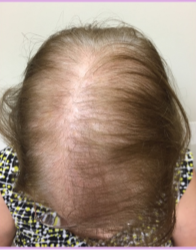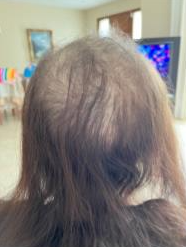
Chemotherapy drugs are powerful and they are designed to attack rapid growing cells.
Our hair follicle growth is a fast-growing highly active cell and currently the drugs cannot differentiate between the two hence hair loss.
Hair loss usually starts to happen around day 19 after the 1st treatment and by 12 weeks the hair loss is complete. You may also lose body hair, including eyelashes, eyebrows, beards, moustaches, chest hair, pubic hair and hair from your nostrils, which will make your nose run and also give you a heightened sense of smell.
While the thought of losing your hair is distressing, most people will see some covering of hair grow back after the treatment, usually between 1-3 months . Many of the patients report a change in hair colour or structure during the first wave of hair regrowth, with many experiencing curlier hair, we call this chemo curl. This is due to a muscle called the arrector pili that is attached to the follicle, it becomes weak and sags during treatment and thus causes your hair to grow at a different angle leading to curly locks. However, these changes are mostly temporary, and hair returns to normal eventually.
Some patients opt for the scalp cold cap but how effective is it?

The cold cap can be effective in preventing or reducing hair loss. But there are no guarantees and you will not know how well it will work for you until you try it. The cold cap works by reducing blood flow to the scalp, which also reduces the amount of chemotherapy medication that reaches this area.
Even if you use the cold cap, you will find that your hair still gets thinner, generally at the top of your head, we call this the halo effect and for some people who are using the cold cap they will still lose their hair. In my experience clients lose between 30 – 50% of their hair. If you have extremely thick hair then you could afford to lose this amount but thinner hair tends to be trickier.
Losing the hair generally is a slower process than traditional treatment and your nurse will usually talk to you about stopping the cold cap if she/ he thinks it isn’t working and no longer a benefit to you.
Most people find that gradually losing their hair while using the cold cap is harder to cope with as you can find yourself in limbo and not knowing which way to turn or do and also after treatment when the hair is growing back it can look somewhat of a mullet as you try and catch the new hair growth up to the existing hair. Many clients opt for a hair topper at the end of treatment to help combat this.
Please note that cold cap only protects the hair on your scalp. Body hair may still fall out, including nostril hair, eyelashes, eyebrows, beards and moustaches, chest hair and pubic hair.
If you are interested in the cold cap, talk to your doctor or nurse. They can tell you if it is available and suitable for you.
So how do you prepare for hair loss?
There are things that you can do to help you feel more in control when your hair starts to fall out.
It’s good to talk – Talking to your family and friends will help
People’s reactions to hair loss can sometimes be very difficult to cope with. It can help if you talk about it first. Once they hear you talking about your hair loss, they may be able to offer you more help and support.
If you have children, you may worry that they will be scared if they see you without hair. However, most children usually cope really well when they are told about any changes to your appearance in advance.
Joining a support group for hair loss
Talking to others with hair loss is important, it can give you a real insight and you can exchange ideas on how to cope and what tips and tricks they may have learnt along the way in their journey.
Check out www.cancerhaircare.co.uk they are a brilliant charity that can help you through your journey whatever your needs and can go into more details with anything above that may concern you.
Get a wig before treatment starts
If your already thought about the wig route it would be a good idea to get one before you start treatment. It will be easier to match the wig to your own hair colour and style. You can get used to wearing the wig before your hair starts to fall out. It will also be ready in case your hair loss happens earlier or quicker than you expect. www.mynewhair.org has a list of salons that care that can help you with fitting or if you need it cut in or customised in your local area.
Buy a hat or other headwear
Your scalp will be most definitely more sensitive to cold, windy or sunny weather. Even at home or asleep your head may feel very cold if you have been used to having a full head of hair. Some people find they prefer to wear a turban / bandana, instead of a wig, it is a personal choice. Click here to see our turbans and bandanas
Lashes and eyebrows
Losing your eyelashes and eyebrows can be a worry. Start using products before you lose them, this way you will have some idea of where to place them and it will come a little more naturally, if and when it happens. Please note: If you plan to use false lashes you must test the glue on your wrist 24 hours before to check that it doesn’t cause a reaction.
